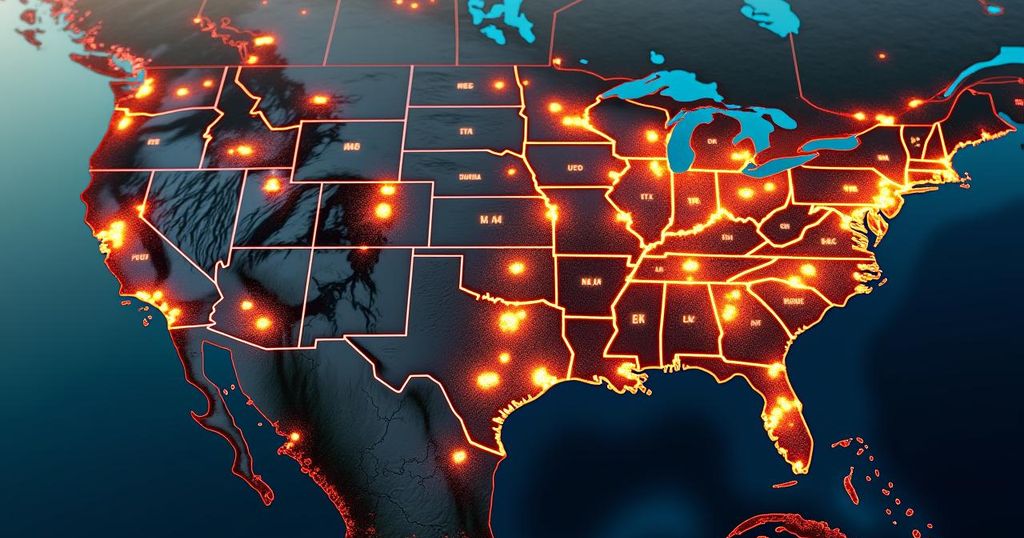4.1 Magnitude Earthquake Reported in Montana

On October 7, 2024, a 4.1-magnitude earthquake was registered in Dillon, Montana, following several significant seismic events across the United States, including previous earthquakes in California, Tennessee, and Idaho. The USGS indicated a notable pattern of seismic activity leading up to this recent event.
On October 7, 2024, a 4.1-magnitude earthquake occurred in Montana, as reported by the United States Geological Survey (USGS). The earthquake’s epicenter was located in Dillon, situated at a depth of 13.7 kilometers (approximately 8.5 miles). At the time of the report, USGS received approximately 120 accounts from residents who felt the tremor. This seismic event followed a 3.7-magnitude earthquake that struck California on October 5, 2024, with its epicenter in Petrolia at a depth of 10.0 kilometers (about 6.2 miles). Prior to these occurrences, Tennessee experienced a 2.5-magnitude earthquake on October 3, 2024, centered at a depth of 9.7 kilometers (approximately six miles). Just the day before, a 3.5-magnitude earthquake was recorded off the coast of Oregon, also at a depth of 13.5 kilometers (about 8.4 miles). Earlier, a sequence of California earthquakes also occurred, including a 3.5-magnitude event in Avenal at a depth of 11.4 kilometers (about 7 miles), and another similar event in Ontario with a depth of merely 4.1 kilometers (around three miles). This chain of seismic activity began with a 2.7-magnitude earthquake in Idaho on September 30, 2024, emanating from Bonners Ferry at a depth of 9.1 kilometers (approximately 5.7 miles). The Idaho quake was preceded by a significant 6.3-magnitude earthquake recorded near the Réunion region of Mauritius on September 26, 2024, at a considerable depth of 10 kilometers (about six miles). Notably, a 4.0-magnitude earthquake was noted in Saanichton, Canada, on the same day. Further back, both Romania and Texas experienced sizable quakes on September 16: a 5.2-magnitude earthquake centered in Cașoca at a depth of 133.5 kilometers (around 83 miles) and a 5.1-magnitude event in Ackerly at 8.2 kilometers (approximately 5.1 miles) deep. The earthquake in Texas occurred after a 3.4-magnitude quake in Kansas on September 19, located in Danville at a depth of 4.9 kilometers (about three miles). The Northern Mariana Islands also reported a 6.3-magnitude earthquake on September 16, centered in Saipan at a depth of 42.9 kilometers (around 26.7 miles), concluding the recent series of global seismic events.
The frequency and magnitude of earthquakes in North America, particularly on the West Coast and surrounding areas, have been a subject of scientific interest and public concern. Earthquake preparedness and response measures, as well as understanding the geological dynamics that cause these seismic events, are crucial for minimizing potential damages and safeguarding lives. The United States Geological Survey plays an integral role in monitoring seismic activity, providing data, and facilitating public awareness regarding earthquake occurrences.
In summary, the recent 4.1-magnitude earthquake in Montana is part of a broader pattern of seismic activity that has affected various regions in the United States and beyond. With earthquakes ranging from 2.5 to 6.3 in magnitude reported within a span of just over a week, it is vital for preparedness and awareness regarding such natural events. The importance of monitoring by the United States Geological Survey cannot be overstated, as it provides essential information that aids in public safety and disaster response.
Original Source: www.iheart.com







